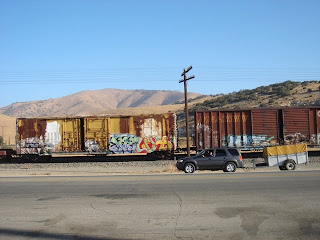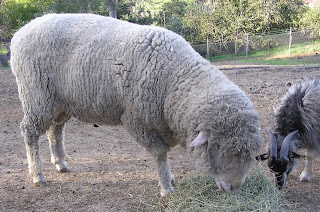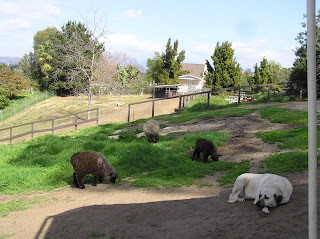I don’t know if
STITCHES West is THE best event of my year, but it is certainly one of the top five. It is always filled with joy and anxiety and stress and delight and a stunning amount of humility as I realize that I am a very small little fish in the enormous pond of knitters and fiber artists/addicts. It’s market is a thrilling extravaganza of fiber temptations, the classes are brain-bulging tests of concentration, memory and understanding, and the fiber-watching opportunities simply astound.
For the past half-dozen years I have spoiled myself with almost-annual pilgrimages to the Bay area in order to take a few classes, shop and dream at the market, ogle some beautiful knitting, and maybe have a room-service meal. For the past few years my daughter (below R, learning how to knit with a silk "hankie") has been able to meet me for a night and maybe a class, but this year she has a baby, in addition to her job, so I made time to visit grands before and after the convention.
Over the years I have enjoyed classes with Lily Chin, Chris Bylsma, Maggie Jackson (below L)
and many, many more excellent and inspiring teachers. This year I signed up for a class on Substituting Yarn, by Kellie Nuss, which was an excellent crash course in all things pattern and fiber related; a full day of spinning cotton on a charkha wheel, with Eileen Hallman; a class on making a needle-felted pet, with Sharon Costello; a refresher on spindle spinning with Merike Saarniit,
and a market class on Knitting in Both Directions, or knitting back backwards. Yeah, that's it exactly -- brain twisting but interesting!
I had lunch with a friend from home, who also attended, and dropped in on the intarsia seminar, which was quite beyond me in all but the "gee whiz" respect. One experience that was totally new and fresh was being able to attend "preview" night at the market. This is the first evening of the convention, and is open only to students and teachers, so it is a great chance to actually talk with folks and take your time in a wonderfully uncrowded hall. With over 1200 booth spaces, this is a real luxury.
I was wandering around this wonderland in a total daze, when I finally stopped in at a very nice booth called
Urban Fauna. It was chocked full of interesting stuff, and had beautiful skeins of handspun yarn done by various artists hanging on the back wall, so of course I had to go look. I stepped over a new
Mach I spinning wheel, but on the way out stopped to watch as another lady sat down to try it out. I was surprised to find that it was made just 30 or 40 miles from where I live, and surprised again to learn that the lady trying it out was Eileen Hallman, the instructor for my charkha class the following day. I told her that I was looking forward to the class because I had a bag of brown cotton, given to me by an elderly gentleman at one of the farmer's markets that I wanted to learn to spin. Really? She wanted to know what city the market was in, and when I told her that it was a small little spot, she became very insistent on knowing the name. Vista, I told her, in northern San Diego county.
She stared at me with her mouth open, and said, "I
know where it is; I used to live there. Those plants could be from my yard!!" We eagerly started reminiscing. I told her I had an old spinning friend who used to live on the same street; she not only knew her, but had learned to spin cotton there. And then the kicker. She looked at my name tag and muttered "Fallbrook ... I used to go spin with a group at someone's house there, but her name wasn't Lambert." "Yeah," I said, "I remarried." Well, to say we were both gobsmacked would not do it justice. It was a kick.
I brought my baggie of cotton to the class, bought a charkha book wheel from her (she owns and runs
New World Textiles, in NC) and was so busy learning to use it that I forgot about the raw
The book charkha, opened (left) and white (Pima), green and "mauve" raw cotton (right).
brown cotton until break. At that point, Eileen picked up the bag and rushed over to hold it under a light. She did one of those comedy-skit double-takes -- looking at me, then the bag, then back to me again -- and finally said, "You don't know what you have here." I agreed, shaking then nodding my head: I had no clue. "This isn't brown cotton, she continued, "this is MAUVE cotton." She went on to tell me how rare it was, and even in Peru was becoming impossible to find , let alone export. "Are you sure you want to give me the whole bag?" she finally asked. I gave in to baser instincts, worried that my little supplier might never return to the market, and gave her half. But I think we both were quite happy, with our cotton and our discoveries.
The needle felting class was great fun, but I sort of complicated things by bringing pictures of my sheep instead of a dog or a cat. When she said, "All of you who are doing dogs sit on this side, and all of you who are doing cats sit on the other side," I knew I was in trouble. Still, I think I learned enough to be able to complete my 'omage to Gwendolynn ... one of these days.
 Gwendolynn, immortalized in needle felt, from her own wool.
Gwendolynn, immortalized in needle felt, from her own wool.It was a wonderful three days that recharged my batteries and have given me a massive dose of enthusiasm.
And don't even get me started on the darling grand daughters!


Bay area babes: Lalima (6 months) and Kavina (9 months).
Next: Sheep eggs, etc.





















































